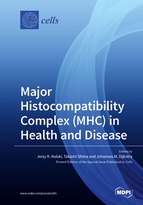Major Histocompatibility Complex (MHC) in Health and Disease
A special issue of Cells (ISSN 2073-4409).
Deadline for manuscript submissions: closed (31 May 2019) | Viewed by 94026
Special Issue Editors
2. School of Psychiatry and Clinical Neurosciences, The University of Western Australia, Crawley, WA 6009, Australia
Interests: immunogenetics and biology of the Major Histocompatibility Complex, genomics, retroelements
Special Issues, Collections and Topics in MDPI journals
Interests: immunogenetics and biology of the major histocompatibility complex; genomics; retroelements
Special Issues, Collections and Topics in MDPI journals
Special Issue Information
Dear Colleagues,
The Major Histocompatibility Complex (MHC) antigen presenting molecules consist of two primary classes of glycoproteins that bind peptides derived from intracellular or extracellular antigens and play an integral role in adaptive and innate immune defense systems. They are present in all classes of jawed vertebrates. The MHC genes are polygenic and encode a set of MHC molecules with different ranges of peptide-binding specificities that can be divided into MHC class I and MHC class II depending on their structure and phylogeny. Typically, species have several highly polymorphic genes of both class I and class II, so that there are multiple variants of those genes within the population. Particular combinations of MHC alleles are known as MHC haplotypes.
The MHC classical class I molecules are expressed on the cell surface of all nucleated cells including neuronal cells in the brain, and they can present peptides derived from intracellular proteins or cellular-infected viral proteins to circulating CD8+ cytotoxic T-cells. The MHC class I molecules can also serve as inhibitory ligands for natural killer (NK) cells. In comparison, the MHC class II genes encode for cell-surface glycoproteins that bind extracellular peptides and present them to circulating CD4+ T helper cells. The expression of MHC class II genes is a characteristic of professional antigen-presenting cells such as dendritic cells, macrophages, and B cells, but expression also can be found in several other cell types. The term MHC stems historically from its role in graft rejection and tissue compatibility within donor–recipient pairs. The extensive polymorphism between the MHC molecules probably protects populations from different invading pathogens, and yet, in the clinic, it adds to the difficulty of finding matched pairs for successful transplantation outcomes.
The MHC genes, haplotypes, and polymorphic molecules are investigated continuously due to their crucial role in the regulation of innate and adaptive immune responses; the pathogenesis of numerous infectious and/or autoimmune diseases; brain development and plasticity; olfaction; therapeutic vaccinations and T cell-based immunotherapy; and the compatibility of grafted tissue, which also concerns potential graft-versus-host disease involving hematopoietic stem cell transplants. Recent reports describe a role for neuronal MHC-I in synaptic plasticity, brain development, axonal regeneration, neuroinflammatory processes, and immune-mediated neurodegeneration. In humans, the MHC (HLA) genes are part of the supra-locus on chromosome 6p21 known as the human leukocyte antigen (HLA) system. This genomic complex consists of more than 200 genes, some located closely together as haplotype blocks and involved in inflammatory and immune-response, heat shock, and complement cascade systems; cytokine signalling; and the regulation of various aspects of cellular development, differentiation, and apoptosis. Also, there are thousands of putative microRNA encoding loci within HLA genes and the HLA genomic region that may be expressed by different cell types and play a role in the regulation of immune-response genes and in the etiology of numerous diseases.
The aim of this Special Issue is to examine further the role of the polymorphic MHC class I and class II genes, haplotypes, and molecules in health and disease in humans and other species in particular with respect to cellular functions. Analysing the structure, function, and disease associations of the MHC class I and class II genes and molecules in human and other species will improve our understanding of their role in innate and adaptive immunity, neurology and brain disease, autoimmunity, infectious diseases, cancer, and self and non-self recognition.
Dr. Jerzy K. Kulski
Prof. Takashi Shiina
Dr. Johannes M. Dijkstra
Guest Editors
Manuscript Submission Information
Manuscripts should be submitted online at www.mdpi.com by registering and logging in to this website. Once you are registered, click here to go to the submission form. Manuscripts can be submitted until the deadline. All submissions that pass pre-check are peer-reviewed. Accepted papers will be published continuously in the journal (as soon as accepted) and will be listed together on the special issue website. Research articles, review articles as well as short communications are invited. For planned papers, a title and short abstract (about 100 words) can be sent to the Editorial Office for announcement on this website.
Submitted manuscripts should not have been published previously, nor be under consideration for publication elsewhere (except conference proceedings papers). All manuscripts are thoroughly refereed through a single-blind peer-review process. A guide for authors and other relevant information for submission of manuscripts is available on the Instructions for Authors page. Cells is an international peer-reviewed open access semimonthly journal published by MDPI.
Please visit the Instructions for Authors page before submitting a manuscript. The Article Processing Charge (APC) for publication in this open access journal is 2700 CHF (Swiss Francs). Submitted papers should be well formatted and use good English. Authors may use MDPI's English editing service prior to publication or during author revisions.
Keywords
- MHC
- HLA
- function
- structure
- innate and adaptive immunity
- autoimmunity
- antigen presentation
- disease









